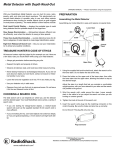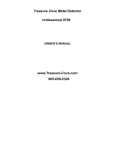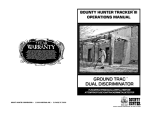Download Radio Shack Detector Owner`s manual
Transcript
Cat. No. 63-3011 OWNER’S MANUAL Please read before using this equipment. Three-Mode Discriminator Metal Detector with Analog Signal-Strength Meter FEATURES With your RadioShack Three-Mode Discriminator Metal Detector with Analog Signal-Strength Meter, you can hunt for coins, jewelry, gold, and silver, just about anywhere. The detector is designed to be versatile and easy to use. Loaded with features but simple to operate, the detector lets you locate and identify all types of metals with pinpoint accuracy. It can distinguish between different types of metals and “tune out” the ones you don’t want to search for. Discrimination and Tone Control — lets you adjust the detector’s discrimination and adjust the tone it sounds. This lets you set the detector so you can quickly tell when it has found the type of metal you are searching for, and automatically ignore junk metal while you search. Two-Tone Audio Discrimination — sounds distinctive tones for different types of metals, to make target identification easier. The detector’s features include: Low Battery Indicator — lets you know when it is time to replace the batteries. Easy-to-Read Viewmeter — lets you quickly see the strength of an indication when the detector finds metal. S-Rod Handle with Arm Cup — lets you comfortably hold and use the detector for long periods. Target Mode Control — lets you easily select the detector’s operation modes. Automatic Tuning and Ground Balancing — let you quickly use the detector without time-consuming adjustments. Waterproof 7-Inch Searchcoil — lets you use the searchcoil under water, and use the detector in just about any type of weather. Built-In Speaker — lets you use the detector without headphones. Headphone Jack — lets you connect headphones with a 1/4 inch plug (not supplied) to the detector. Sensitivity Control — turns on the detector and lets you adjust its sensitivity. Note: Your metal detector requires two 9-volt alkaline batteries (not included) for operation. © 1998 Tandy Corporation. All Rights Reserved. RadioShack is a registered trademark used by Tandy Corporation. 2 OPTIONAL ACCESSORY The 7-inch searchcoil supplied with your detector efficiently finds deeplyburied objects, and is ideal for general use. However, if you are looking for tiny objects (coin-sized and smaller) that are not buried too deeply, a 4-inch searchcoil (such as RadioShack Unlimited No. 10484954, not supplied) might work better for you. This searchcoil is highly sensitive and offers superior performance when hunting for small objects such as gold nuggets or small pieces of jewelry, or when hunting in mineralized or highly trashy areas. Because of its smaller size, it has a narrower detection field and is less susceptible to interference from junk metal. This makes it better able to isolate precious metals in these areas. 3 CONTENTS Preparation ........................................................................................................ Assembling the Detector ............................................................................... Installing Batteries ........................................................................................ Using Headphones ....................................................................................... Traffic Safety ........................................................................................... 5 5 6 7 7 Understanding the Detector ............................................................................. 8 Operation ...................................................................................................... 8 Viewmeter ............................................................................................... 8 SENSITIVITY ......................................................................................... 8 DISC/ALL METAL/TONE ........................................................................ 8 DISC/TONE ............................................................................................ 8 Testing the Detector ...................................................................................... 9 Holding the Detector .................................................................................... 10 Using the Detector ....................................................................................... 10 Fine-Tuning the Detector ............................................................................. 11 Adjusting SENSITIVITY ........................................................................ 11 Adjusting DISC/TONE .......................................................................... 12 Pinpointing a Target ..................................................................................... 12 False Signals ............................................................................................... 13 Troubleshooting .............................................................................................. 14 Care and Maintenance .................................................................................... 15 Treasure Hunter’s Code of Ethics .................................................................. 16 4 PREPARATION ASSEMBLING THE DETECTOR Assembling your detector is easy and requires no special tools. Just follow these steps. 1. Loosely attach the searchcoil to the lower stem using the supplied bolt and knurled knob. Do not tighten the bolt and knob yet. 2. While holding down the button on the top of the lower stem, slide the lower stem tube into the upper stem tube. 3. Adjust the stem to a length that lets you comfortably stand upright. The stem should be long enough to let you comfortably hold the detector so the searchcoil is level to the ground and about 1/2 to 2 inches above the ground with your arm relaxed at your side. 4. Adjust the searchcoil to the desired position, then tighten it by turning the bolt and knob in opposite directions until they stop. Caution: Do not overtighten the searchcoil or use tools such as pliers to tighten it. 5. Wind the searchcoil’s cable around the stem. Leave enough slack in the cable to let you adjust the searchcoil when you are hunting on uneven ground. 6. Insert the searchcoil’s plug into the matching connector on the detector’s control housing. Make sure the pins on the plug align with the holes in the connector. 5 Cautions: • The searchcoil’s plug fits into the connector only one way. Do not force it. 3. Snap a 9-volt battery onto each battery terminal, then slide the batteries inside the compartment. • To disconnect the searchcoil’s cable from the detector, grasp the plug and pull it out of the connector. Never pull on the cable. INSTALLING BATTERIES You must use two 9-volt alkaline batteries (such as Cat. No. 23-553) to power your detector. Cautions: • Use only fresh batteries of the required size and type. 4. Carefully insert the tabs on the battery compartment door into the slots on the detector, then press in on the door until it clicks to close it. LOW BAT on the front of the detector flashes once when you turn off the detector. • Do not mix old and new batteries or different types of batteries (standard or alkaline). 1. If the detector is on, turn it off by turning SENSITIVITY on the front panel fully counterclockwise toward OFF/POWER until it clicks. 2. While holding down the release clip on the right side of the battery compartment door, lift off the door. If LOW BAT lights during normal use or the detector sounds a long continuous tone or does not function properly, replace both batteries. Cautions: • If you do not plan to use the detector for a week or more, remove the batteries. Batteries can leak chemicals that can destroy electronic parts. 6 • Dispose of old batteries promptly and properly. Do not burn or bury them. USING HEADPHONES Traffic Safety You can connect a pair of stereo headphones (not supplied) to the detector so you can listen to it privately. Using headphones also saves battery power and makes it easier to identify subtle changes in the sounds you hear, for better detection results. Your local RadioShack store has a wide selection of headphones. Do not wear headphones while operating your detector near high traffic areas. Even though some headphones let you hear some outside sounds when listening at normal volume levels, they still can present a traffic hazard. To connect headphones to the detector, insert the headphones’ 1/4-inch (6.35 mm) plug into HEADPHONE on the front panel. The detector’s internal speaker disconnects when you connect headphones. Notes: • Mono headphones do not work with the detector unless you connect a mono-to-stereo adapter such as Cat. No. 274-1520 (not supplied) between the headphone jack and the detector. • You cannot use the detector to adjust the headphone’s volume. 7 UNDERSTANDING THE DETECTOR OPERATION Your RadioShack Three-Mode Discriminator Metal Detector with Analog Signal-Strength Meter is a “motion” detector. This means that you must move the searchcoil slightly to detect the presence of metal (see “Pinpointing a Target” on Page 12). The motion required is slight, and pinpointing targets is very easy as long as the metal is under the searchcoil and the searchcoil is moving. Viewmeter The detector’s viewmeter is on the front of the control housing. The meter’s needle swings to the right when an object is detected. DISC/ALL METAL/TONE This control lets you select any of the detector’s three operating modes. DISC — at this setting, the detector au- tomatically rejects iron and can be adjusted to reject most trash items. The detector sounds a unique tone when it detects metal. ALL METAL — at this setting, the detector sounds a single tone when it detects any type of metal. TONE — at this setting, the detector automatically rejects iron and sounds 2 unique tones when it detects metal and DISC/TONE has been properly adjusted (see “Adjusting DISC/TONE” on Page 12). DISC/TONE SENSITIVITY Use this control to turn the detector on or off and increase or decrease the detector’s sensitivity at any operational setting. 8 This control is for adjusting the discrimination when DISC/ALL METAL/ TONE is set to DISC or TONE (see “Adjusting DISC/TONE” on Page 12). TESTING THE DETECTOR To learn how the detector reacts to different metals, you should test it before you use it the first time. 1. Turn on the detector by turning SENSITIVITY clockwise until it clicks. The detector beeps and the viewmeter’s needle swings to the right, then returns to the left. 2. Adjust SENSITIVITY until it is about halfway between OFF and HIGH. 3. Set DISC/ALL METAL/TONE to the desired setting (see “DISC/ALL METAL/TONE” on Page 8). 4. Lay the detector on a wooden or plastic table, then remove any watches, rings, or metal jewelry you are wearing. Note: Never test the detector on a floor inside a building. Most buildings have metal of some kind in the floor, which will interfere with the objects you are testing or mask the signal completely. 6. Make sure the detector is set to detect the type of metal you are using to test it (see “Adjusting DISC/TONE” on Page 12). 7. Slowly move a sample of the material you want the detector to find (such as a gold ring or a coin) side-to-side 1–2 inches above the face of the searchcoil. Note: If you are using a coin, the detector will detect it more easily if you hold it so a flat side (not the edge) is parallel with the flat side of the searchcoil. If the detector detects the material, it sounds a tone and the viewmeter’s needle swings to the right. If the detector does not detect the material, make sure DISC/ALL METAL/TONE is correctly set for the type of metal you are searching for, then repeat this step. 5. Adjust the searchcoil so the flat part points toward the ceiling. 9 HOLDING THE DETECTOR Stand with your arm extended only slightly in front of your body. Do not bend or stoop, but stand in an upright position that is comfortable. 5. Place a sample of the material you want the detector to find (such as a gold ring or a coin) on the ground. (If you are using valuable metal such as gold to test the detector, mark the area where you placed the item, to help you find it later. Do not place it in tall grass or weeds). 6. While holding the searchcoil level to the ground, about 1–2 inches above the surface, slowly move it over the area where you placed the sample, sweeping in a side-toside motion. Hold the detector so the searchcoil is about 1–2 inches above the ground. Then adjust the searchcoil so it is parallel to the ground. USING THE DETECTOR 1. Turn on the detector by turning SENSITIVITY clockwise until it clicks. The detector beeps and the viewmeter’s needle swings to the right, then returns to the left. 2. Adjust SENSITIVITY until it is about halfway between OFF and HIGH. 3. Set DISC/ALL METAL/TONE to the desired setting (see “DISC/ALL METAL/TONE” on Page 8). 4. Find an area of ground where there is no metal. 10 Never sweep the searchcoil as if it were a pendulum. Raising the searchcoil while sweeping or at the end of a sweep will cause false readings. And sweep slowly — hurrying will cause you to miss targets. If DISC/ALL METAL/TONE is set to TONE and DISC/TONE has been properly adjusted (see “Adjusting DISC/TONE” on Page 12), the detector sounds a unique audio tone for each of three categories of metal. This makes it easier to identify the type of metal being detected. As shown here, the detector sounds a low tone when it detects small gold and nickels, a broken tone when it detects most pull tabs and some gold and zinc, and a high tone when it detects copper, silver, and brass. searchcoil over the target a few times, the target is probably junk metal. • False signals can be caused by trashy ground, electrical interference, or large oddly-shaped pieces of junk metal. 7. Try finding other metal in the area. When you find a metal item, wait a few seconds after the tone stops before continuing, to allow the detector time to reset. If DISC/ALL METAL/TONE is set to TONE and DISC/TONE has been properly adjusted, the detector sounds a unique audio tone for items such as bottle caps, zinc pennies, and pull tabs. Note: Since these indications are approximations, the detector might not have actually found the item it indicates. The indicators are only references to help you decide if an item is worth investigating. If the detector does not detect the item you placed on the ground, make sure DISC/ALL METAL/TONE is correctly set for the type of metal you are searching for (see “DISC/ ALL METAL/TONE” on Page 8), then repeat this step. Also, make sure you are moving the searchcoil correctly. Notes: • The detector responds with a strong signal when it detects most valuable metal objects. If a signal is broken or does not repeat after you sweep the FINE-TUNING THE DETECTOR After you become familiar with how your detector works, you can fine-tune it to make it less sensitive to interference and more selective in what it finds. For example, you can set it so it ignores most junk metal such as pull tabs or bottle caps, but still registers silver and copper coins. Adjusting SENSITIVITY For maximum detection depth, always adjust SENSITIVITY set as high as possible while using the detector. But broadcast antennas and power lines can cause the detector to indicate false signals and operate erratically. Adjust SENSITIVITY lower to help reduce or eliminate these false signals. Turn SENSITIVITY clockwise to increase it, or counterclockwise to reduce it. 11 Notes: • SENSITIVITY also turns the detector on and off. • If you set the detector’s sensitivity too high, the detector might sound false tones. Adjusting DISC/TONE PINPOINTING A TARGET Accurately pinpointing a target while detecting makes digging it up easier. Accurately pinpointing small metal objects takes practice. We suggest that you practice finding and digging up small metal objects on your own property before you search other locations. Discrimination is the detector’s ability to differentiate between types of metal and either find or ignore them. DISC/ TONE adjusts the detector’s discrimination. Follow these steps to pinpoint a target. When DISC/ALL METAL/TONE is set to DISC, adjust DISC/TONE so the tab is pointing straight up and slightly clockwise (toward HIGH) to set the detector to ignore items such as bottle caps, zinc pennies, nickels, small gold items, and pull tabs, while still detecting items such as silver and copper coins. Or, when DISC/ALL METAL/TONE is set to TONE, adjust DISC/TONE counterclockwise (toward LOW) to find all such items. 2. Make a visual note of the exact spot on the ground where the detector beeps. Notes: 5. If necessary, “X” the target at different angles to zero in on the exact spot on the ground where the detector beeps. • Adjusting DISC/TONE has no effect while DISC/ALL METAL/TONE is set to ALL METAL. • If you set DISC/ALL METAL/TONE to TONE then set the detector’s discrimination too high, the detector will not detect gold items and nickels. 12 1. When the detector detects a buried target, continue sweeping the searchcoil over the target in a narrowing side-to-side motion. 3. Stop the searchcoil directly over this spot on the ground. Then move the searchcoil straight forward away from you and straight back toward you a couple of times. 4. Make a visual note of the exact spot on the ground where the detector beeps. Note: The detector beeps just as the center of the searchcoil passes directly over the buried target. If you have difficulty pinpointing very strong signals, try lifting the searchcoil higher off the ground until a weaker but more concise signal is heard. For very weak signals, move the coil in short quick sweeps close to the ground. FALSE SIGNALS Your detector is extremely sensitive, and will detect even deeply-buried metal. Because of this, trash-induced signals and other sources of interference might cause signals that seem confusing. The key to handling these types of signals is to dig for only those targets that emit a strong, repeatable signal. As you sweep the searchcoil back and forth over the ground, learn to recognize the difference between signals that occur at random and signals that are stable and repeatable. To reduce false signals when searching very trashy ground, scan only a small area at a time using slow, short overlapping sweeps. To help prevent erratic signals and pinpoint targets in trashy areas, try a smaller searchcoil (see “Optional Accessory” on Page 3). 13 TROUBLESHOOTING If you have problems, here are some suggestions that might help. If none of these suggestions help, take your detector to your local RadioShack store for assistance. PROBLEM The detector displays or sounds false signals. SUGGESTION The sensitivity might be set too high. Adjust SENSITIVITY counterclockwise. You might be sweeping the detector’s searchcoil too fast or at the wrong angle. Sweep the searchcoil more slowly and hold the detector correctly. See “Using the Detector” on Page 10 and “Pinpointing a Target” on Page 12. The detector might sound a false signal if it detects some types of heavily oxidized metals. Try pinpointing the target from several different angles (see “Pinpointing a Target” on Page 12). If the detector does not display and sound the same signal each time, the target is probably heavily oxidized metal. The detector sounds only one kind of tone, and discrimination does not work. DISC/ALL METAL/TONE is set to ALL METAL or DISC. This is not a malfunction. Set DISC/ALL METAL/TONE to TONE (see “DISC/ALL METAL/TONE” on Page 8). The detector sounds a constant loud tone or constant repeating tones. The batteries might be weak. Replace the batteries. You are operating the detector near another detector or near power lines. Power lines can interfere with the frequency that the detector operates on. The detector does not turn on, has weak volume, will not tune properly, operates erratically, or drifts. 14 The batteries might be weak. Replace the batteries. CARE AND MAINTENANCE Your RadioShack Three-Mode Discriminator Metal Detector with Analog SignalStrength Meter is an example of superior design and craftsmanship. The following suggestions will help you care for your detector so you can enjoy it for years. Keep the detector’s chassis dry and do not let water enter it. If the chassis gets wet, wipe it dry immediately. Liquids might contain minerals that can corrode the electronic circuits. The searchcoil supplied with the detector is waterproof however, and may be submerged in either fresh or salt water. After using the searchcoil in salt water, rinse it with fresh water to prevent corrosion of the metal parts. Use and store the detector only in normal temperature environments. Temperature extremes can shorten the life of electronic devices, damage batteries, and distort or melt plastic parts. Handle the detector gently and carefully. Dropping it can damage circuit boards and cases and can cause the detector to work improperly. Use only fresh batteries of the required size and type. Batteries can leak chemicals that damage your detector’s electronic parts. Wipe the detector with a damp cloth occasionally to keep it looking new. Do not use harsh chemicals, cleaning solvents, or strong detergents to clean the detector. Modifying or tampering with the detector’s internal components can cause a malfunction and might invalidate your detector’s warranty. If your detector is not performing as it should, take it to your local RadioShack store for assistance. 15 TREASURE HUNTER’S CODE OF ETHICS All treasure hunters might be judged by the example you set. Here are a few basic rules you should follow while using your detector. • Always obtain permission before searching any site. • Respect the rights and property of others. • Observe all national, state, and local laws while treasure hunting. • Never destroy historical or archaeological treasures. If you are not sure about an object you have found, contact a museum or historical society in your area. • Leave the land and vegetation as it was. Fill in any holes you dig. • Use your detector only in safe areas. • Dispose of any junk you find, only in approved areas. Do not leave it for the next treasure hunter to find. Limited Ninety-Day Warranty This product is warranted by RadioShack against manufacturing defects in material and workmanship under normal use for ninety (90) days from the date of purchase from RadioShack company-owned stores and authorized RadioShack franchisees and dealers. EXCEPT AS PROVIDED HEREIN, RadioShack MAKES NO EXPRESS WARRANTIES AND ANY IMPLIED WARRANTIES, INCLUDING THOSE OF MERCHANTABILITY AND FITNESS FOR A PARTICULAR PURPOSE, ARE LIMITED IN DURATION TO THE DURATION OF THE WRITTEN LIMITED WARRANTIES CONTAINED HEREIN. EXCEPT AS PROVIDED HEREIN, RadioShack SHALL HAVE NO LIABILITY OR RESPONSIBILITY TO CUSTOMER OR ANY OTHER PERSON OR ENTITY WITH RESPECT TO ANY LIABILITY, LOSS OR DAMAGE CAUSED DIRECTLY OR INDIRECTLY BY USE OR PERFORMANCE OF THE PRODUCT OR ARISING OUT OF ANY BREACH OF THIS WARRANTY, INCLUDING, BUT NOT LIMITED TO, ANY DAMAGES RESULTING FROM INCONVENIENCE, LOSS OF TIME, DATA, PROPERTY, REVENUE, OR PROFIT OR ANY INDIRECT, SPECIAL, INCIDENTAL, OR CONSEQUENTIAL DAMAGES, EVEN IF RadioShack HAS BEEN ADVISED OF THE POSSIBILITY OF SUCH DAMAGES. Some states do not allow the limitations on how long an implied warranty lasts or the exclusion of incidental or consequential damages, so the above limitations or exclusions may not apply to you. In the event of a product defect during the warranty period, take the product and the RadioShack sales receipt as proof of purchase date to any RadioShack store. RadioShack will, at its option, unless otherwise provided by law: (a) correct the defect by product repair without charge for parts and labor; (b) replace the product with one of the same or similar design; or (c) refund the purchase price. All replaced parts and products, and products on which a refund is made, become the property of RadioShack. New or reconditioned parts and products may be used in the performance of warranty service. Repaired or replaced parts and products are warranted for the remainder of the original warranty period. You will be charged for repair or replacement of the product made after the expiration of the warranty period. This warranty does not cover: (a) damage or failure caused by or attributable to acts of God, abuse, accident, misuse, improper or abnormal usage, failure to follow instructions, improper installation or maintenance, alteration, lightning or other incidence of excess voltage or current; (b) any repairs other than those provided by a RadioShack Authorized Service Facility; (c) consumables such as fuses or batteries; (d) cosmetic damage; (e) transportation, shipping or insurance costs; or (f) costs of product removal, installation, set-up service adjustment or reinstallation. This warranty gives you specific legal rights, and you may also have other rights which vary from state to state. RadioShack Customer Relations, Dept. W, 100 Throckmorton St., Suite 600, Fort Worth, TX 76102 We Service What We Sell 3/97 RadioShack A Division of Tandy Corporation Fort Worth, Texas 76102 3/98 Printed in the USA



























